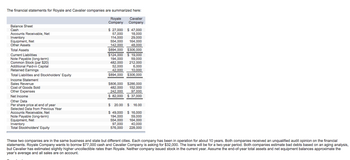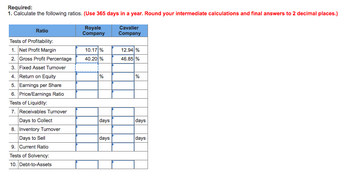
FINANCIAL ACCOUNTING
10th Edition
ISBN: 9781259964947
Author: Libby
Publisher: MCG
expand_more
expand_more
format_list_bulleted
Question
Please do not give image format and explanation

Transcribed Image Text:The financial statements for Royale and Cavalier companies are summarized here:
Royale Cavalier
Company
Company
Balance Sheet
Cash
Accounts Receivable, Net
Inventory
Equipment, Net
Other Assets
Total Assets
Current Liabilities
Note Payable (long-term)
Common Stock (par $20)
Additional Paid-in Capital
Retained Earnings
Total Liabilities and Stockholders' Equity
Income Statement
Sales Revenue
Cost of Goods Sold
Other Expenses
Net Income
Other Data
Per share price at end of year
Selected Data from Previous Year
Accounts Receivable, Net
Note Payable (long-term)
Equipment, Net
Inventory
Total Stockholders' Equity
$ 27,000 $ 47,000
57,000
18,000
29.000
114,000
554,000 164,000
142,000
48,000
$894,000 $306,000
$124,000 $19,000
194,000
59,000
482,000 212,000
6,000
10,000
$894,000 $306,000
52,000
42,000
$806,000 $286,000
482,000
242,000
$ 82,000
152,000
97,000
$37,000
$ 20.00 $ 16.00
$ 49,000
$16,000
194,000 59,000
554,000 164,000
97,000 40,000
576,000 228,000
These two companies are in the same business and state but different cities. Each company has been in operation for about 10 years. Both companies received an unqualified audit opinion on the financial
statements. Royale Company wants to borrow $77,000 cash and Cavalier Company is asking for $32,000. The loans will be for a two-year period. Both companies estimate bad debts based on an aging analysis,
but Cavalier has estimated slightly higher uncollectible rates than Royale. Neither company issued stock in the current year. Assume the end-of-year total assets and net equipment balances approximate the
year's average and all sales are on account.

Transcribed Image Text:Required:
1. Calculate the following ratios. (Use 365 days in a year. Round your intermediate calculations and final answers to 2 decimal places.)
Ratio
Tests of Profitability:
1. Net Profit Margin
2. Gross Profit Percentage
3. Fixed Asset Turnover
4. Return on Equity
5. Earnings per Share
6. Price/Earnings Ratio
Tests of Liquidity:
7. Receivables Turnover
Days to Collect
8. Inventory Turnover
Days to Sell
9. Current Ratio
Tests of Solvency:
10. Debt-to-Assets
Royale
Company
10.17 %
40.20 %
%
days
days
Cavalier
Company
12.94 %
46.85 %
%
days
days
Expert Solution
This question has been solved!
Explore an expertly crafted, step-by-step solution for a thorough understanding of key concepts.
This is a popular solution
Trending nowThis is a popular solution!
Step by stepSolved in 5 steps

Knowledge Booster
Similar questions
arrow_back_ios
SEE MORE QUESTIONS
arrow_forward_ios
Recommended textbooks for you

 AccountingAccountingISBN:9781337272094Author:WARREN, Carl S., Reeve, James M., Duchac, Jonathan E.Publisher:Cengage Learning,
AccountingAccountingISBN:9781337272094Author:WARREN, Carl S., Reeve, James M., Duchac, Jonathan E.Publisher:Cengage Learning, Accounting Information SystemsAccountingISBN:9781337619202Author:Hall, James A.Publisher:Cengage Learning,
Accounting Information SystemsAccountingISBN:9781337619202Author:Hall, James A.Publisher:Cengage Learning, Horngren's Cost Accounting: A Managerial Emphasis...AccountingISBN:9780134475585Author:Srikant M. Datar, Madhav V. RajanPublisher:PEARSON
Horngren's Cost Accounting: A Managerial Emphasis...AccountingISBN:9780134475585Author:Srikant M. Datar, Madhav V. RajanPublisher:PEARSON Intermediate AccountingAccountingISBN:9781259722660Author:J. David Spiceland, Mark W. Nelson, Wayne M ThomasPublisher:McGraw-Hill Education
Intermediate AccountingAccountingISBN:9781259722660Author:J. David Spiceland, Mark W. Nelson, Wayne M ThomasPublisher:McGraw-Hill Education Financial and Managerial AccountingAccountingISBN:9781259726705Author:John J Wild, Ken W. Shaw, Barbara Chiappetta Fundamental Accounting PrinciplesPublisher:McGraw-Hill Education
Financial and Managerial AccountingAccountingISBN:9781259726705Author:John J Wild, Ken W. Shaw, Barbara Chiappetta Fundamental Accounting PrinciplesPublisher:McGraw-Hill Education


Accounting
Accounting
ISBN:9781337272094
Author:WARREN, Carl S., Reeve, James M., Duchac, Jonathan E.
Publisher:Cengage Learning,

Accounting Information Systems
Accounting
ISBN:9781337619202
Author:Hall, James A.
Publisher:Cengage Learning,

Horngren's Cost Accounting: A Managerial Emphasis...
Accounting
ISBN:9780134475585
Author:Srikant M. Datar, Madhav V. Rajan
Publisher:PEARSON

Intermediate Accounting
Accounting
ISBN:9781259722660
Author:J. David Spiceland, Mark W. Nelson, Wayne M Thomas
Publisher:McGraw-Hill Education

Financial and Managerial Accounting
Accounting
ISBN:9781259726705
Author:John J Wild, Ken W. Shaw, Barbara Chiappetta Fundamental Accounting Principles
Publisher:McGraw-Hill Education